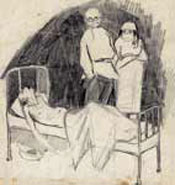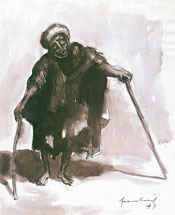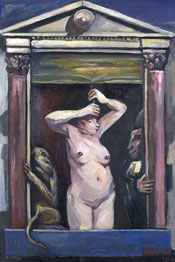| REVIEWS |
|
|
|
We do in fact have some clues
about wartime Russia in Stas’s extraordinarily moving evocations
of life there – all the more powerful for their poverty of
materials and enforced sketchiness. And in those sketches we also
see the foundations of his vision, born, precisely, out of suffering,
and deeply empathetic with suffering, but always with an edge –
satirical or even sardonic. Stas belongs to that line of artists
– he himself I think used to mention Goya – who, standing
slightly at a tangent, look at the human race and its behaviour
and find it much wanting.
Simon Wilson, RWA Exhibition, February 2003 |
| He continued to develop his vision in the
marvellous graphic works he made in Beirut in the immediate post-war
period. These are among the best things he ever did – his
drawing style had matured and he had access to finer materials –
the results are pen, ink and wash drawings, some beautifully heightened
with monochrome colour wash, that are miracles of observation. Simon Wilson, RWA Exhibition, February 2003 |
|
|
|
Frenkiel has a personal voice and a personal
vision and, ….that vision encompassed an extraordinarily broad
sweep of life and an equal sweep of the genres of painting, from
genre itself – everyday life in all its facets - via history
and allegory, to the tradition of the nude. - for Stas the human
was always central. Simon Wilson, RWA Exhibition, February 2003 |
|
PAGE
4 |
|



